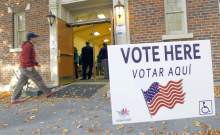This is an archived article that was published on sltrib.com in 2016, and information in the article may be outdated. It is provided only for personal research purposes and may not be reprinted.
It's a sign that Salt Lake Latinos speak English better than some may think: The U.S. Census Bureau on Monday dropped Salt Lake County from the list of jurisdictions that must offer ballots and other voting assistance in Spanish.
The U.S. Department of Justice, using the bureau's data and recommendations, first required Salt Lake County to start such assistance in 2011.
Every five years, the Census Bureau releases a list based on its American Community Survey of which counties in the nation should be required to offer voting assistance in a variety of languages.
The rules are a bit complicated, but essentially such assistance is required if 5 percent of all eligible voters belong to a single-language minority whose proficiency in English would make voting difficult for large numbers of that population.
Data from the 2010-2014 American Community Survey show that Salt Lake County has 163,932 Latinos age 5 or older out of 1.1 million total population. It estimates that 6,162, or 3.8 percent do not speak English at all. Another 19,818, or 12 percent speak English, but "not well."
Salt Lake County is dropping off the list after years of reduced immigration from Mexico following the Great Recession.
"It just plummeted," said Pam Perlich, director of demographic research at the University of Utah's Kem C. Gardner Policy Institute. It reached the point "that more people were returning to Mexico than coming [to Utah]."
"And time passes. So maybe the people who are here have taken advantage of programs to teach them English," said longtime Latino activist Archie Archuleta. "Many of those who need assistance may not be citizens, so it doesn't make a difference since they can't vote anyway."
Richard Jaramillo, president of the Coalition of La Raza of Utah, said fluency has increased as many children of immigrants have grown up attending Utah schools and enter the voting-age group.
Perlich said, "Most immigrants came as young adults and had children. They were born here, and are essentially Americans who are bilingual. Over time, their numbers overwhelmed those of the first generation."
While Archuleta said Census data has historically been accurate, he cautions that trying to use surveys in English to identify how many people do not speak the language is like trying to "count the uncountable."
Archuleta said Latino groups have found that a significant minority of Hispanics who are U.S. citizens continually need help voting because they lack confidence with the language. Jaramillo said his and other groups will work with Salt Lake County Clerk Sherrie Swensen in hopes that she will continue to offer assistance.
"We are still probably pretty close to the cutoff point" where language help is required, he said. "For the benefit of democracy … we hope she keeps some of the programs in place."
Swensen said she is unsure what changes she may make — and must wait for official notification by the U.S. Department of Justice about her options and requirements.
She said the county — Utah's most populous — has not had a large number of requests for Spanish ballots in recent years.
"We get a request for maybe a couple hundred [ballots] in a general election to receive their ballots in Spanish. It isn't a big number," she said.
She adds the county has translated all the signs and voter information on its website to comply with federal requirements.
It has poll workers who are bilingual, and Spanish-speakers on her staff to answer questions as needed.
San Juan County is now the only Utah jurisdiction that is required to offer language assistance: in Navajo and Ute. The American Community Survey estimates that half of that county's residents are American Indian, and that about 19 percent of them speak English "less than well."
The Census recommend that 263 jurisdictions nationally should offer language assistance for voting. They comprise 3.3 percent of the 2,919 counties. It said 68.8 million voting-age people live in those jurisdictions, including 31.3 percent of the total U.S. citizen voting population.



